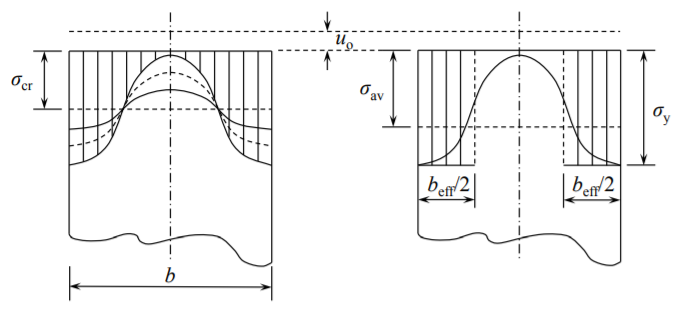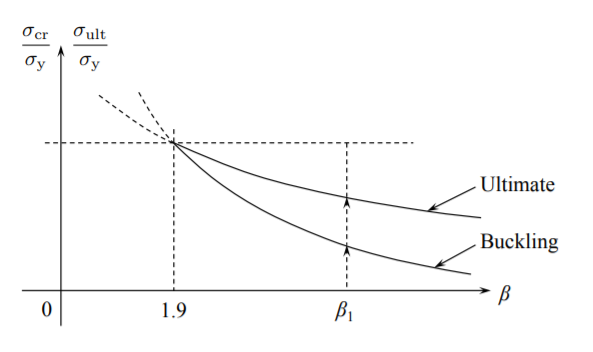10.6: Ultimate Strength of Plates
- Page ID
- 21537
In the previous section we have shown that after buckling the plate continues to take additional load but with half of its pre-buckling stiffness. In order to understand what happens next, let’s examine the distribution of in-plane compressive stresses \(\sigma_{xx}\) at \(x = a\). From Equations (10.2.10-10.2.11) and (??) the components \(\sigma_{xx}\) is
\[\sigma_{xx}(y) = \frac{N_{xx}}{h} = \frac{E}{1 − \nu^2} \left[ −(1 − \nu^2) \frac{u_o}{a} + \frac{\pi^2}{2} \left(\frac{w_o}{a} \right)^2 \sin^2 \frac{\pi y}{a} \right] \]
The first term represents negative, compressive stress, uniform along the width of the plate. The second term describes the relieving tensile stress produced by finite rotation. The relation between \(w_o\) and \(u_o\) is given by Equation (??) and is depicted in Figure (10.5.2). A plot of the function \(\sigma_{xx}(y)\) for several values of the time-like parameter \(u_o\) is shown in Figure (\(\PageIndex{1}\)). Note that the curves labeled A, B, C and D corresponds to the respective points in Figs. (10.5.2) and (10.5.3).

With increasing plate compression there is a re-distribution of stresses along the loaded edge \(x = 0\) and \(x = a\). The stress at the unloaded edge \(y = 0\) and \(y = a\) keeps increasing while the stress at the plate symmetry plane \(y = \frac{a}{2}\) diminishes to zero.
It was the German scientist and engineer, Theodore von Karman who in 1932 made use of the observation presented in Figure (\(\PageIndex{1}\)). He assumed that the central, unloaded portion of the plate carries zero stress while the edge zone, each of the width \(b_{\text{eff}}/2\) reaches the yield stress at the point of ultimate load. As a starting point, von Karman used the expression for the critical buckling load \(N_c\) and looked at the relation between the stress at the loaded edge \(\sigma_e\) and the plate width \(b\)
\[\sigma_e = \frac{N_e}{h} = \frac{N_c}{h} = \frac{4\pi^2D}{hb^2} = \frac{4\pi^2Eh^2}{12(1 − \nu^2)b^2} = 1.9^2E\left(\frac{h}{b}\right)^2\]
Normally \(b\) is the input parameter and the stress \(\sigma_e\) is an unknown quantity. The ingenuity of von Karman was that he inverted what is known and unknown in Equation (??). He asked what should be the width of the plate \(b_{\text{eff}}\) so that the edge stress reaches the yield stress. Thus
\[\sigma_y = 1.9^2E\left(\frac{h}{b_{\text{eff}}}\right)^2\]
Solving the above equation for \(b_{\text{eff}}\)
\[b_{\text{eff}} = 1.9h \sqrt{\frac{E}{\sigma_y}}\]
Taking for example \(E = 200000\) MPa, \(b_{\text{eff}}\sigma_y = 320\) MPa, the effective width becomes
\[b_{\text{eff}} = 1.9h \sqrt{625} = 47.5h \]
The effective width depends on the Young’s modulus and yield stress is proportional to the plate thickness. Approximately 40-50 thicknesses of the plate near the edges carries the load, the remaining central part is not effective. The total load on the plate can be expressed in two ways
\[P_{\text{ult}} = b_{\text{eff}} \cdot \sigma_y = b \cdot \sigma_{\text{av}}\]
where \(\sigma_{\text{av}} = \sigma_{\text{ult}}\) is the average stress on the loaded edge at the point of ultimate strength,
\[\frac{\sigma_{\text{av}}}{\sigma_{\text{ult}}} = \frac{b_{\text{eff}}}{b} = 1.9 \frac{h}{b} \sqrt{\frac{E}{\sigma_y}}\]
The group of parameters
\[\beta = \frac{b}{h} \sqrt{\frac{\sigma_y}{E}}\]
is referred to as the slenderness ratio of the plate. Note that this is a different concept than the slenderness ratio of the column \(l/\rho\). Using the parameter \(\beta\), the ultimate strength of the plate normalized by the yield stress is
\[\frac{\sigma_{\text{ult}}}{\sigma_{y}} = \frac{1.9}{\beta}\]
Recall that the normalized buckling stress of the elastic plate is
\[\frac{\sigma_{\text{cr}}}{\sigma_{y}} = \left(\frac{1.9}{\beta}\right)^2\]
Plots of both functions are shown in Figure (\(\PageIndex{2}\)).
From this figure one can identify the critical slenderness ratio
\[\beta_{\text{cr}} = 1.9 \]
when both the ultimate load and the critical buckling load reach yield. From Equation (??) one can see that at \(\beta = \beta_{\text{cr}}\), the effective width is equal to the plate width, \(b_{\text{eff}} = b\).

Eliminating the parameter \(\beta\) between Equations (??) and (??), the ultimate stress is seen to be the geometrical average between the yield stress and critical buckling stress
\[\sigma_{\text{ult}} = \sqrt{\sigma_{\text{cr}} \cdot \sigma_{y}}\]
For example, continuous loading of a plate with the slenderness ratio \(\beta_1\) will first encounter the buckling curve and then the ultimate strength curve, as illustrated in Figure (\(\PageIndex{2}\)). The foregoing analysis was valid for plates simply supported along all four edges, for which the buckling coefficient is \(k_c = 4\). For other type of support Equation (??) is still valid with the coefficient 1.9 replaced by 1.9 \(\frac{k_c}{4}\).
Much effort has been devoted in the past to validate experimentally the prediction of the von Karman effective width theory. It was found that a small correction to Equation (??) provides good fit of most of the test data
\[\frac{\sigma_{\text{ult}}}{\sigma_{y}} = \frac{b_{\text{eff}}}{b} = \frac{1.9}{\beta} − \frac{0.9}{\beta^2}\]
For example, for a relatively short (stocky plate) \(\beta = 2\beta_{\text{cr}} = 3.8\), the original formula over predicts by 15% than the more exact empirical equation (??). For slender plates, the difference is small. The latter has been the basis for the design of thin-walled compressive elements in most domestic and international standards such as AISI, Aluminum Association and AISC.


